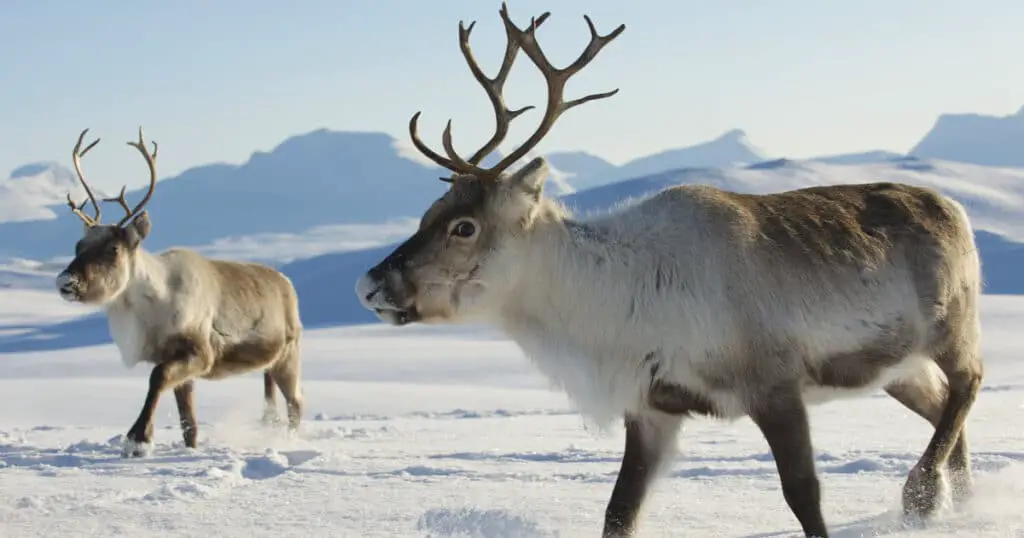Reindeer (Rangifer tarandus) are species of deer found at high latitudes and a number of longitudes around the world. They inhabit cool climates, and are native to the arctic, sub-arctic, tundra, boreal, and mountain ranges of Northern Europe, Siberia, and in North America, where this species is known as the Caribou.
The size and behavior of Reindeer herds varies by location. Some herds are basically sedentary – preferring to stay in one location – while other herds are migratory – meaning they move great distances as a unit.
The herd of the Siberian tundra, known as the Taimyr Herd of Reindeer is the largest herd of wild reindeer in the world, and its numbers vary from 400,000 all the way up to 1,000,000 Reindeer.
In Canada there’s a migratory herd known as the Boreal Woodland Caribou, which varies in size between 28,000 and 385,000.
On this page we’ll introduce you to Reindeer facts and information about how Rangifer tarandus varies in size, behavior, and appearance in different locations around the world.
What Size are Reindeer?
- Head & Body Length – 185 to 220 cm
- Shoulder Height – 82 to 120 cm
- Tail Length – 10 to 15 cm
- Weight – Males 70 to 150 kg. / Females 40-100 kg.
What Do Reindeer Look Like?
Rangifer tarandus lives in the cold tundra of the far north, and is well adapted to this habitat. It is a medium to large species of deer.
General Appearance & Features
Like many of the animals living in cold climates its outermost extremities are reduced in size. A Reindeer’s ears and tail are small to prevent excessive loss of heat.
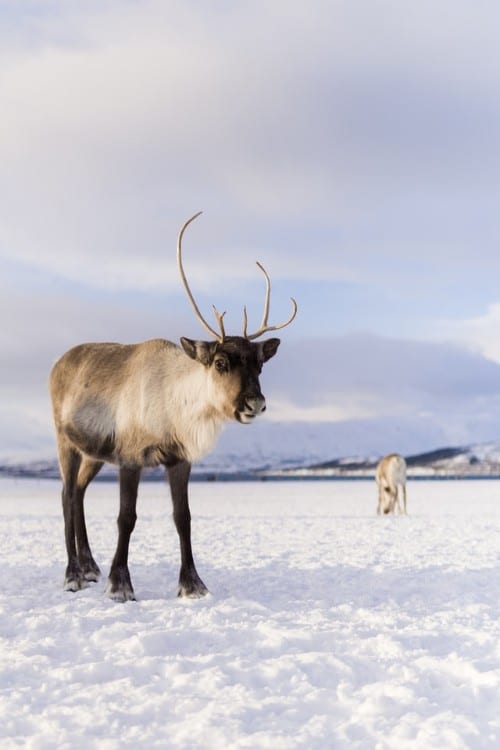
The body is solid and muscular but the legs are short, giving Rangifer tarandus a stocky, compact appearance.
Coat & Coloration
A Reindeer’s coat is extremely thick, and offers excellent insulation in the frigid temperatures of the arctic and sub-arctic regions it inhabits.
The coat is mostly short, but around its head and neck, Rangifer tarandus have longer hair which forms a distinct mane of hairs. The coat ranges in color from a pale creamy color, through to a darker brown.
Normally the under parts are lighter in color than the upper parts. The coat is lighter in color during the winter and darker during the summer months.
A Reindeer’s head is mostly white, except for the muzzle which is usually brown in color.
Reindeer Size
Male Rangifer tarandus tend to be larger than the females. But the primary determinant of Reindeer size is where it lives. Reindeer size can vary considerably depending on the location.
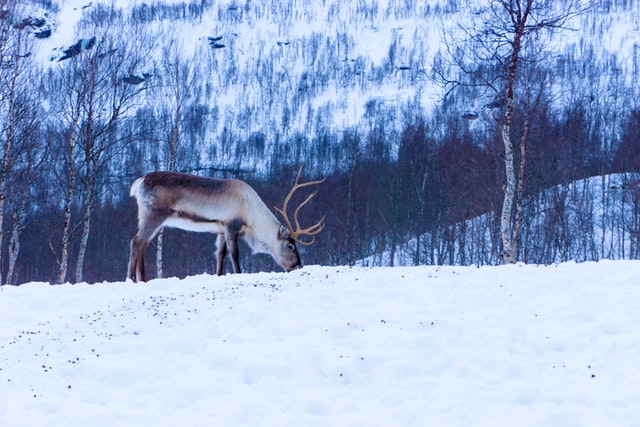
Reindeer found further south tend to be larger than those inhabiting the northern-most locations.
Special Notable Features of Reindeer
Reindeer possess a number of special adaptations which allow them to thrive in cold climates.
For example, male Rangifer tarandus develop a thick layer of fat beneath the skin that helps store energy and provides insulation.
The fur of a Reindeer’s feet is especially long, and it acts like treads beneath their hooves. This allows Reindeer to maintain a firm grip on slippery and icy surfaces.
A Reindeer’s feet themselves are very broad, a feature which allows Rangifer tarandus to move quickly over snow without sinking in, almost like snowshoes.
Why do Female Reindeer Have Antlers?
The Reindeer is the only species of deer in which the females carry antlers as well as the males. This is thought to be because females can use the antlers to find food. In snow the antlers are used to scrape snow away from the ground, and as such they are an important feature for survival.
Female Reindeer may also use their antlers to help defend the young from predators.
Generally speaking the antlers of female Reindeer are not as thick and stocky as those of the males.
More About Reindeer Antlers
The size and shape of Rangifer tarandus antlers can vary considerably between animals. Usually the antlers grow in a long curving arc, first backwards but then curving back to point to the front again.
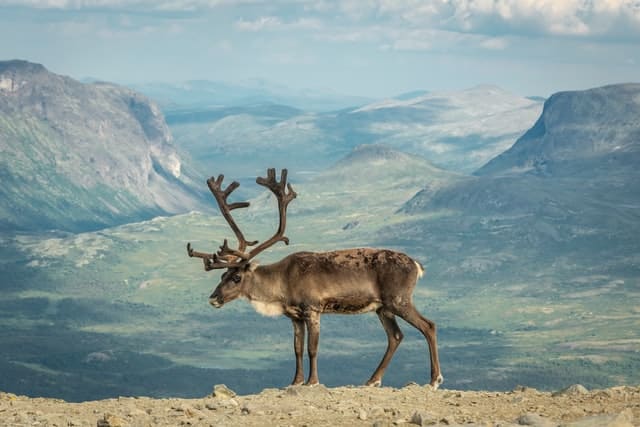
The antlers can have various numbers of tines. At the end of the antlers may be a short part that is flattened into a short blade.
The antlers are lost each year and regrown afresh, covered in velvet, which is eventually shed. Females lose their antlers in spring after their young have been born. Males lose their antlers after the rut has finished in late autumn.
After the antlers have been lost a new set begins to grow immediately and are normally ready by the following autumn.
Reindeer Subspecies
There are several subspecies of Reindeer. Three subspecies are found in Europe, and Four in the Americas.
In the Americas this animal is known as the Caribou, while in Europe it is called the Reindeer.
Some use the term Caribou to refer to all wild living animals, and the name Reindeer to refer to those animals that are semi-domesticated by Santa or others.
More About the Habitat & Range of Reindeer
As we mentioned earlier, Rangifer tarandus is found in the northern coniferous forests and the open barren tundra plains of the arctic and far north.
They have a circumpolar distribution range (meaning they are found at high latitudes, and many longitudes around the globe).
You can find wild herds of Reindeer across northern Europe, Asia and North America.
How Long do Reindeer Live?
With the exception of Rudolph and Santa’s other Reindeer (who are magical creatures and live forever), the maximum lifespan of wild living Reindeer is between 10 and 15 years.
However few animals reach this age due to the presence of predators and the hostile climates in which they live.
The average maximum age for Reindeer is about 4 years.
Beyond arctic predators, insects tend to be an often overlooked cause of early mortality among wild Reindeer.
What do Reindeer Eat?
Reindeer have a hard life, and finding enough food to survive is one of the biggest challenges they face.
As a result, Reindeer choose the best plants, rich in nutrition. This allows them to obtain enough energy to continue to seek out food and stay warm.
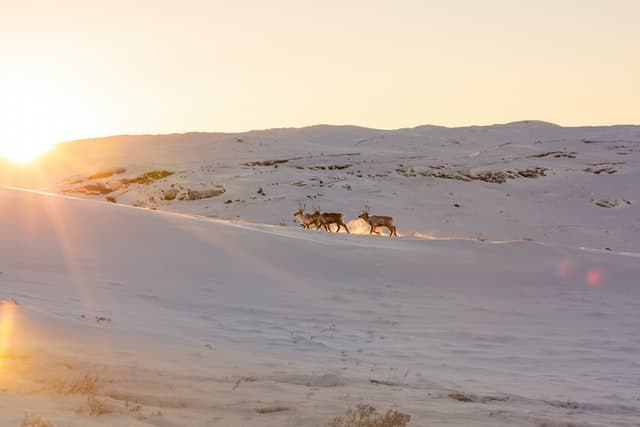
In the winter months Rangifer tarandus is famous for feeding on lichens, and during the winter they will scrape snow away from these so they can feed.
They are well known for feeding on one type of lichen in particular, a food source which is known as Reindeer Lichen (Cladina rangiferina).
In the summer, a Reindeer’s diet is much more varied. They will feed on a variety of grasses and herbaceous plants.
Mating & Reproduction in Rangifer tarandus
In Reindeer the rutting period takes place between September and October depending on the location in which they live.
The rut only last a few days, and the exact timing of this annual ritual depends on the latitude at which the reindeer live.
In Reindeer, mating is very competitive.
Males try to collect together a small number of females, which they can then mate with as they come into season. Other males will try to fight these males for the possession of these small groups.
How do Reindeer Fight?
Reindeer fight by locking their antlers and trying to push each other away.
Usually the most dominant male wins these contests and obtains possession of the small harem of females.
Successful males may be able to collect together as many as 20 females to mate with in a given season.
Gestation & Birth
The gestation period for these deer is 210 to 240 days long.
Normally only a single Reindeer calf is born. Most of the young are born in June. At birth the calves weigh ~5 kg.
Rangifer tarandus calves are able to walk within an hour of birth. They have to become mobile quickly because of the danger of predators such as wolves and bears.
Growth occurs quickly, with the young reaching 35 kg by October.
The mother Reindeer’s milk is especially rich and high in fats to support young Reindeer in the harsh climate. The young are suckled by their mothers for 4 to 5 months, but start to eat green matter when they are only a few weeks of age.
Sexual maturity in Reindeer is reached at about 2 years of age.
Unique Reindeer Behavior
Perhaps the most notable Reindeer behavior is the ability to fly, but this is reserved for Reindeer in Santa’s herd. Wild Reindeer cannot fly.
Migrations
The Caribou of North America are famous for their long migrations.
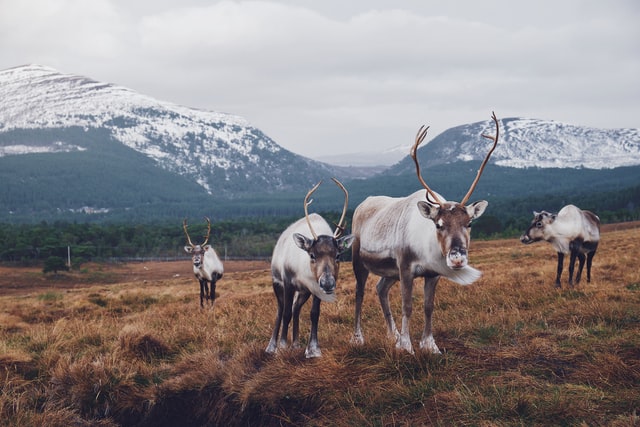
At the beginning of spring they form into large herds that can number into the tens of thousands. These herds move slowly northwards towards the traditional calving grounds and away from the Boreal forests.
After the calves are born, Caribou continue northwards to new feeding grounds on the tundra where they spread out and spend the summer.
As autumn approaches they begin to collect together into herds again and move south to find shelter from the harsh winter weather.
When Caribou reach the forests they disperse and try to find shelter and food beneath the trees.
What Causes These Migrations?
Two main factors influence this migratory behavior.
- Firstly during the summer months the tundra area becomes alive, and is an excellent resource of food for the Rangifer tarandus. By moving northwards the Caribou can take advantage of all this food that no other animals can use.
- Another factor causing them to move northwards are the numerous airborne parasites that attack the Caribou. As spring starts these begin to hatch out and attack the Caribou. Insects like midges will bite Caribou and try to suck their blood, this can cause the Caribou to lose a large amount of blood and weaken the animals considerably. Other insects may lay there eggs on Caribou and when these hatch out into maggots they eat into the Caribou causing injury and death. To avoid these attacks Caribou move northwards where it is cooler. On the open plains there is more wind that helps to blow insects away.
Do All Rangifer tarandus Migrate?
Not all Caribou migrate. Many populations of Rangifer tarandus are sedentary and remain in the same place all year round.
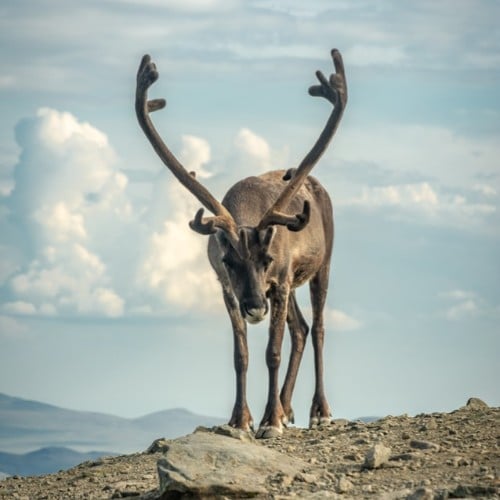
The most famous migrations occur in Alaska and Canada. Reindeer in northern Europe and Asia are less migratory in behavior.
Scandinavian Reindeer Herds
The Sami people of Northern Europe have semi-domesticated the Rangifer tarandus herds of northern Scandinavia.
These herds of Rangifer tarandus are still free to roam where they like, but they are followed by the Sami people.
Each family owns a herd of Reindeer, which they hunt for meat and skins, and even milk. The Sami people are one of the few remaining nomadic people remaining in the wild. Their survival is tied to that of the Rangifer tarandus herds they follow.

